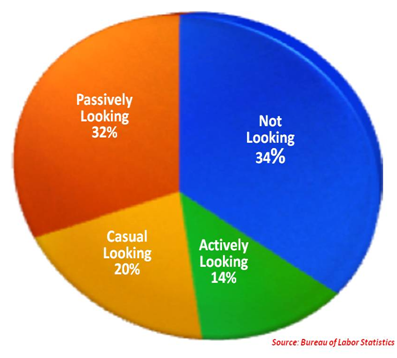 While attending the Social Recruiting Summit in Minneapolis back in May, I made specific note of a common sentiment expressed by recruiting representatives of two social recruiting powerhouses – Best Buy and Facebook: They don’t have any trouble attracting people, but they do have a tough time attracting the right people.
While attending the Social Recruiting Summit in Minneapolis back in May, I made specific note of a common sentiment expressed by recruiting representatives of two social recruiting powerhouses – Best Buy and Facebook: They don’t have any trouble attracting people, but they do have a tough time attracting the right people.
Recruiters in attendance scoffed at the thought that these two great companies with fantastic brands would have problems attracting talent.
However, I wasn’t surprised – not in the least. And I’ll tell you why.
Talent Attraction Offers Very Little Control
Talent attraction efforts, social media-based or otherwise, offer a near-total lack of control over precisely who gets attracted.
Having a great corporate brand coupled with a great employer brand will draw strong interest and response, but it doesn’t give you the ability to choose who you attract, whether they come in the form of referrals, ad responses, or resume submissions.
Talent Attraction Efforts are Passive and Non-Selective
Talent attraction is an intrinsically passive and non-selective strategy. Even if you use a state of the art interactive recruiting solution that pushes your content all over the Internet in a highly targeted manner (inasmuch as such efforts are limited to surface-level targeting), you have no control over who actually sees, perceives, or acts upon your content (jobs, tweets, Facebook/YouTube videos, etc.).
That’s right – even if you can be guaranteed to get your content in front of precisely the right people (and you can’t), it doesn’t mean they will actually “see” your content, even if their look directly at it, let alone take action.
Why?
Passive and Non-Job Seekers Don’t “See” Employer / Employment Content
The majority of people – approximately 66% – aren’t really looking for a job, or even thinking about making a change.
People who are not really looking to make a change in their employment tend to not even perceive employment-related content.
If you just bought a vehicle, or perhaps if you just like your current vehicle – do you notice car ads? Sure – if you’re into cars. But to someone who isn’t specifically interested in cars, they will not even register a car advertisement, no matter how interesting or compelling. Even if they were to “see” a car advertisement for a vehicle that they found highly appealing – how often do you think they would take a decisive action to buy that specific vehicle if they didn’t actually need a new one?
Changing jobs is a stressful event – supposedly one of the most stressful events that can occur in your life, along with getting married, moving your home, getting divorced, and coping with the death of a loved one.
No matter how compelling the employer branding content/message, as a passive strategy, a recruiter/employer is leaving the decision to act or not to act in the hands of the potential candidate.
If changing jobs is a highly stressful event, even for active job seekers, imagine how difficult is actually is to not only get someone who really isn’t looking to make a change in their employment to #1 actually perceive employer branding/job content, and #2 take specific action on it.
It’s a shame that too few sourcers and recruiters take the time to think about what the world looks like through the eyes of a passive or non-job seeking “A” player.
Don’t Just Set Traps – Go Hunting!
Relying heavily on pushing content and hoping that the right people see it and actually take action upon it will leave you constantly struggling to attract enough of the right people. Companies need to put just as much, if not more energy and effort into taking an active role in seeking out and identifying, contacting, engaging, and recruiting the right people – whether they’re looking for a new job or not.
Searching for people is an active strategy that is a selective process which affords you the ability to precisely control who you find, engage and recruit. Directly messaging and calling the right people who you’ve specifically searched for and identified puts the power of action in the hands of the sourcer/recruiter.
Well over half of the people I’ve recruited were “not looking” when I found them and made contact. Those are hires that would never have happened had I waited for them to notice my content and take action (or not!) or be referred to me.
Final Thoughts
While the “war for talent” would be a whole lot easier if simply placing employer branding content and jobs in front of people via social media and traditional channels would net you large quantities of the right talent, it simply doesn’t work that way, nor will it ever.
It can’t.
Talent attraction strategies and tactics, regardless of the medium utilized, are passive and non-selective strategies and afford no control over who is attracted.
Of course, every employer should post jobs and publish employer branding content via social media to attract talent – it works, especially for people who are actively and casually looking for new employment opportunities.
But if you’re having trouble attracting enough of the right people, don’t just sit back and hope for them to notice and take action in response to your posting or your Twitter/LinkedIn/Facebook content, or to be referred to you – take initiative and control and go find and engage them.
Because the majority of the right people won’t come to you, and they’re certainly not seriously thinking of taking action to make a change in employment.
